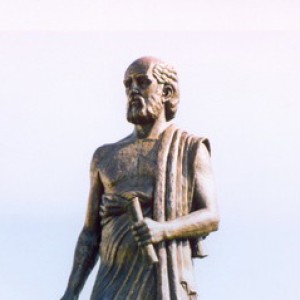Aristarchus of Samos quotes
Proposition 14. The straight line joined from the centre of the earth to the centre of the moon has to the straight line cut off from the axis towards the centre of the moon by the straight line subtending the (circumference) within the earth's shadow a ratio greater than that which 675 has to 1.

Aristarchus of Samos
Proposition 13. The straight line subtending the portion intercepted within the earth's shadow of the circumference of the circle in which the extremities of the diameter of the circle dividing the dark and the bright portions in the moon move is less than double of the diameter of the moon, but has to it a ratio greater than that which 88 has to 45; and it is less than 1/9th part of the diameter of the sun, but has to it a ratio greater than that which 22 has to 225. But it has to the straight line drawn from the centre of the sun at right angles to the axis and meeting the sides of the cone a ratio greater than that which 979 has to 10125.

Aristarchus of Samos
We are now in a position to prove the following propositions : -
1. The distance of the sun from the earth is greater than eighteen times, but less than twenty times, the distance of the moon (from the earth); this follows from the hypothesis about the halved moon.
2. The diameter of the sun has the same ratio (as aforesaid) to the diameter of the moon.
3. The diameter of the sun has to the diameter of the earth a ratio greater than that which 19 has to 3, but less than that which 43 has to 6; this follows from the ratio thus discovered between the distances, the hypothesis about the shadow, and the hypothesis that the moon subtends one fifteenth part of a sign of the zodiac.

Aristarchus of Samos
Proposition 1. Two equal spheres are comprehended by one and the same cylinder, and two unequal spheres by one and the same cone which has its vertex in the direction of the lesser sphere; and the straight line drawn through the centres of the spheres is at right angles to each of the circles in which the surface of the cylinder, or of the cone, touches the spheres.

Aristarchus of Samos
Proposition 5. When the moon appears to us halved, the great circle parallel to the circle which divides the dark and the bright portions in the moon is then in the direction of our eye; that is to say, the great circle parallel to the dividing circle and our eye are in one plane.

Aristarchus of Samos
![[Hypotheses]
1. That the Moon receives its light from the sun.
2. That the earth is in the relation of a point and centre to the sphere in which the moon moves.
3. That, when the moon appears to us halved, the great circle which divides the dark and the bright portions of the moon is in the direction of our eye.
4. That, when the moon appears to us halved, its distance from the sun is then less than a quadrant by one-thirtieth of a quadrant.
5. That the breadth of the (earth's) shadow is (that) of two moons.
6. That the moon subtends one fifteenth part of a sign of the zodiac. (Aristarchus of Samos)](https://cdn.quotesdtb.com/img/quotes_images_webp/16/aristarchus-of-samos-breadth-853716.webp)

 Born: 310 BC
Born: 310 BC
